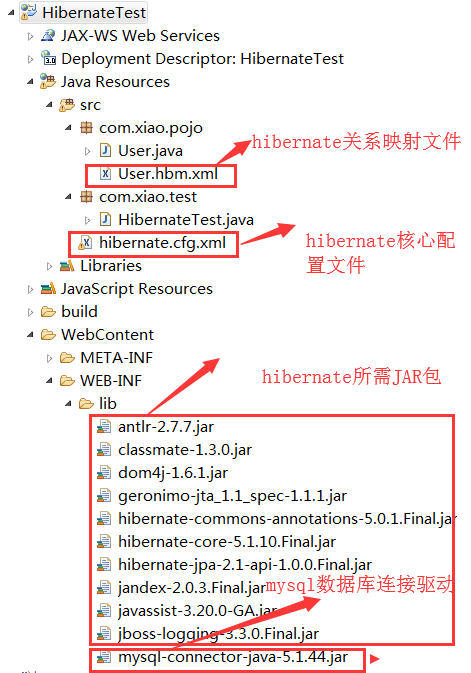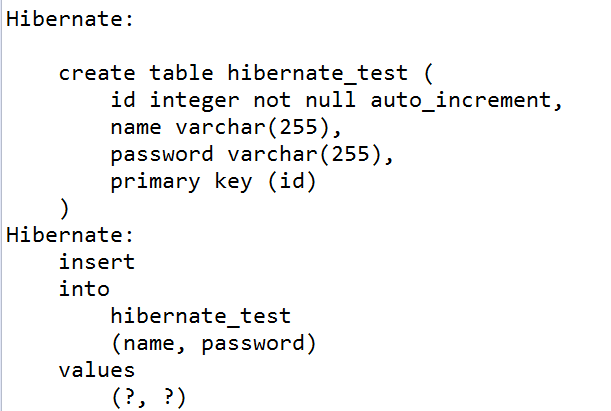Eclipse搭建Hibernate框架 Demo
阿新 • • 發佈:2019-01-30
第一步:首先去官網下載需要的JAR包 地址:http://hibernate.org/ (我這裡使用的是5.1.10版本的)
第二步:建立動態web專案,工程目錄結構如下:
第三步:書寫hibernate核心配置檔案-hibernate.cfg.xml:(切記:資料庫連線資訊改成自己的)
<?xml version="1.0" encoding="UTF-8"?> <!DOCTYPE hibernate-configuration PUBLIC "-//Hibernate/Hibernate Configuration DTD 3.0//EN" "http://www.hibernate.org/dtd/hibernate-configuration-3.0.dtd"> <hibernate-configuration> <session-factory> <!-- 在解壓檔案 hibernate-release-5.1.10.Final\project\etc 目錄下 在檔案hibernate.properties中搜素mysql 就可以看見如下name屬性 #hibernate.dialect org.hibernate.dialect.MySQLDialect #hibernate.dialect org.hibernate.dialect.MySQLInnoDBDialect #hibernate.dialect org.hibernate.dialect.MySQLMyISAMDialect #hibernate.connection.driver_class com.mysql.jdbc.Driver #hibernate.connection.url jdbc:mysql:///test #hibernate.connection.username gavin #hibernate.connection.password --> <!-- 必須的五項配置 這是使用的Hibernate自帶的連線池,不用於生產環境--> <property name="hibernate.connection.driver_class">com.mysql.jdbc.Driver</property> <property name="hibernate.connection.url">jdbc:mysql://localhost:3306/all_db</property> <property name="hibernate.connection.username">root</property> <property name="hibernate.connection.password">root</property> <property name="hibernate.dialect">org.hibernate.dialect.MySQLDialect</property> <!-- 在解壓檔案 hibernate-release-5.1.10.Final\project\etc 目錄下 在檔案hibernate.properties中搜素show就可以看見如下name屬性 --> <!-- #hibernate.show_sql true --> <property name="hibernate.show_sql">true</property> <!--#hibernate.format_sql true --> <property name="hibernate.format_sql">true</property> <!-- 在解壓檔案 hibernate-release-5.1.10.Final\project\etc 目錄下 在檔案hibernate.properties中搜素hbm2就可以看見如下name屬性 #hibernate.hbm2ddl.auto none 不讓Hibernate維護表 #hibernate.hbm2ddl.auto create-drop 每次建立一個新表,執行完程式刪除這個表 #hibernate.hbm2ddl.auto create 每次建立一個新表 #hibernate.hbm2ddl.auto update 資料庫中有表,使用原來的,沒有,建立一個新的,可以更新表結構 #hibernate.hbm2ddl.auto validate 只會使用原有的表,對對映關係進行校驗 --> <property name="hibernate.hbm2ddl.auto">update</property> <!-- 載入對映檔案 --> <mapping resource="com/xiao/pojo/User.hbm.xml"/> </session-factory> </hibernate-configuration>
第四步:書寫實體類-User.java:
package com.xiao.pojo; /** * @author 笑笑 * * 2017年12月7日下午10:19:15 */ public class User { private Integer id = 0; private String name = null; private String password = null; public Integer getId() { return id; } public void setId(Integer id) { this.id = id; } public String getName() { return name; } public void setName(String name) { this.name = name; } public String getPassword() { return password; } public void setPassword(String password) { this.password = password; } @Override public String toString() { return "User [id=" + id + ", name=" + name + ", password=" + password + "]"; } }
第五步:書寫對映檔案-User.hbm.xml:
<?xml version="1.0" encoding="UTF-8"?> <!DOCTYPE hibernate-mapping PUBLIC "-//Hibernate/Hibernate Mapping DTD 3.0//EN" "http://www.hibernate.org/dtd/hibernate-mapping-3.0.dtd"> <hibernate-mapping> <class name="com.xiao.pojo.User" table="hibernate_test"> <!-- 對映主鍵 --> <id name="id" column="id"> <generator class="native"></generator> </id> <!-- 對映其他欄位,如果實體類與表的欄位相一致,可以省略 --> <property name="name" column="name" /> <property name="password" column="password" /> </class> </hibernate-mapping>
第六步:書寫測試類-HibernateTest.java:
package com.xiao.test;
import org.hibernate.Session;
import org.hibernate.SessionFactory;
import org.hibernate.Transaction;
import org.hibernate.cfg.Configuration;
import org.junit.Test;
import com.xiao.pojo.User;
/**
* @author 笑笑
*
* 2017年12月7日下午10:58:12
*/
public class HibernateTest {
@Test
public void test(){
Configuration cfg = new Configuration().configure();//載入主配置檔案
SessionFactory sf = cfg.buildSessionFactory();
Session session = sf.openSession();
Transaction tx = session.beginTransaction();
User user = new User();
user.setName("笑笑");
user.setPassword("123");
session.save(user);
tx.commit();
session.close();
sf.close();
}
}
第七步:執行Junit測試,控制輸出如下資訊:
到此,hibernate框架搭建成功!


